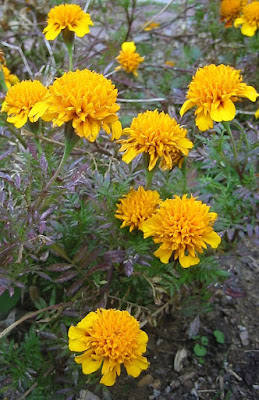I often grow the dwarf French marigolds as infill border plants never growing more than 8 inches tall (20 cm). One of my favorites is "Tiger Eyes" with the red bottom petals and orange-yellow pom poms. But near the end of each growing season, the red color and the orange tint goes away. The blooms become uniformly yellow.
I thought it might be the cooler weather affecting the coloring as it does some plants. Or, it might be the shorter day length that was causing the change, much like a poinsettia depends on longer nights for its red blooms. I discovered the reason my marigold change color this year by accident.
It is neither the day length nor the temperature that causes the loss of red. The plant simply gets tired. This marigold seed blooms true to its parent. As summer progresses I deadhead the spent blooms, leaving them around the ground near the plant. Some of the seed heads sprouted and grew new plants. Since we had a long growing season this year, getting our first killing frost only last week, these volunteer spouts had enough time to bloom.
The blooms were as colorful as a day in spring, despite the cooler fall temperatures and the shorter days. While the older plants nearby were haggard and blooming uniformly yellow, the new plants were red, robust, and orange-yellow as they were planted in spring. This tells me that as the plant gets old, its bloom colors simply change, like we do.
There is nothing I can do other than to sow successive plantings throughout the summer, something that is not going to happen. We will accept the change as a natural pattern.
20 November 2016
15 November 2016
Springing From The Compost
In mid summer, a few vines emerged at the base of the side garden tomato plants. The new plants looked like late sprouts of the zucchini seeds I planted but lost track of when they did not germinate. The seedlings were no problem since one can never have too much zucchini with the evil squash vine borer lurking.
I let these grow, and about a month later realized that they were not zucchini. The two looked more like watermelon or cantaloupe vines. As the season turned to fall, a few fuzzy green balls appeared, about the size of baseballs. The wrinkled netting on the surface identified them as cantaloupe. Strangely, the netting surface covered only one half of the small fruit.
Last month near Halloween, the tops began to show signs of rot, so the fruit was picked and cut open. Each looked like a cantaloupe inside with a saturated orange flesh. It tasted like one too, but unfortunately not as sweet as the store bought.
Some seeds from the compost that I used around the tomato plants sprouted, and the compost did have cantaloupe. I have had tomato seeds sprout from compost, but never cantaloupe. The plants were most likely some parent of a hybrid bred for the stores.
I let these grow, and about a month later realized that they were not zucchini. The two looked more like watermelon or cantaloupe vines. As the season turned to fall, a few fuzzy green balls appeared, about the size of baseballs. The wrinkled netting on the surface identified them as cantaloupe. Strangely, the netting surface covered only one half of the small fruit.
Last month near Halloween, the tops began to show signs of rot, so the fruit was picked and cut open. Each looked like a cantaloupe inside with a saturated orange flesh. It tasted like one too, but unfortunately not as sweet as the store bought.
Some seeds from the compost that I used around the tomato plants sprouted, and the compost did have cantaloupe. I have had tomato seeds sprout from compost, but never cantaloupe. The plants were most likely some parent of a hybrid bred for the stores.
Labels:
cantaloupe,
compost
Subscribe to:
Comments (Atom)








